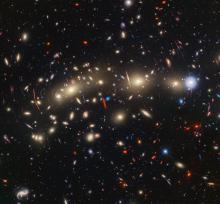Listen to today's episode of StarDate on the web the same day it airs in high-quality streaming audio without any extra ads or announcements. Choose a $8 one-month pass, or listen every day for a year for just $30.
You are here
Neptune Opposition II
Several billion years ago, a giant space rock slammed into Proteus, the second-largest moon of the planet Neptune. The impact blasted rock and ice into orbit around Neptune. Eventually, some of that material came together to form another moon.
That’s the scenario outlined by the astronomers who discovered the moon, which they announced early this year. They named it Hippocamp, after a mythological creature that was half horse, half fish.
Hippocamp is Neptune’s 14th known moon, and the smallest of them all — only about 20 miles in diameter. It was discovered by a team led by Mark Showalter. The astronomers combined images from Hubble Space Telescope that were taken starting in 2004. That revealed the moon and allowed the scientists to plot its orbit. It’s about 50,000 miles above Neptune’s clouds.
Hippocamp’s orbit brings it to within about 7500 miles of the orbit of Proteus — one of the clues to the little moon’s birth. A giant crater mars the surface of Proteus. The impact that created it would have blasted out more than enough material to make Hippocamp — Neptune’s most recently discovered moon.
And Neptune is at its best right now. The planet will line up opposite the Sun on Monday. It rises around sunset and stays in the sky all night. And it’s brightest for the year, too. Even so, you’ll need a telescope to pick out the giant planet. It’s in the eastern sky at nightfall, near the edge of the constellation Aquarius.
Script by Damond Benningfield





